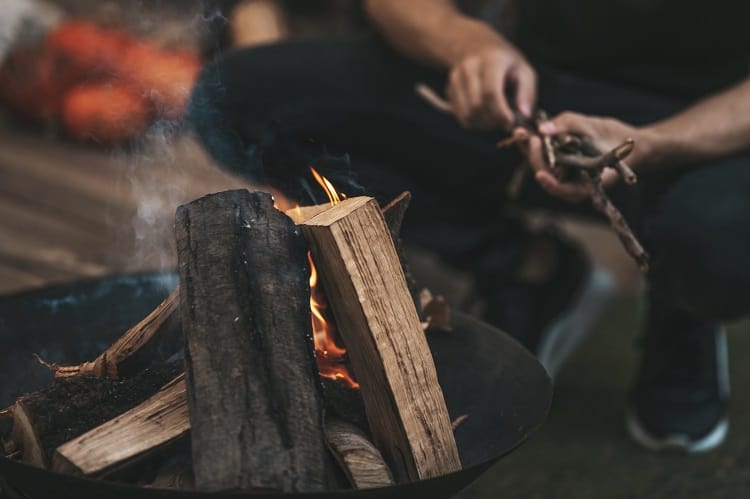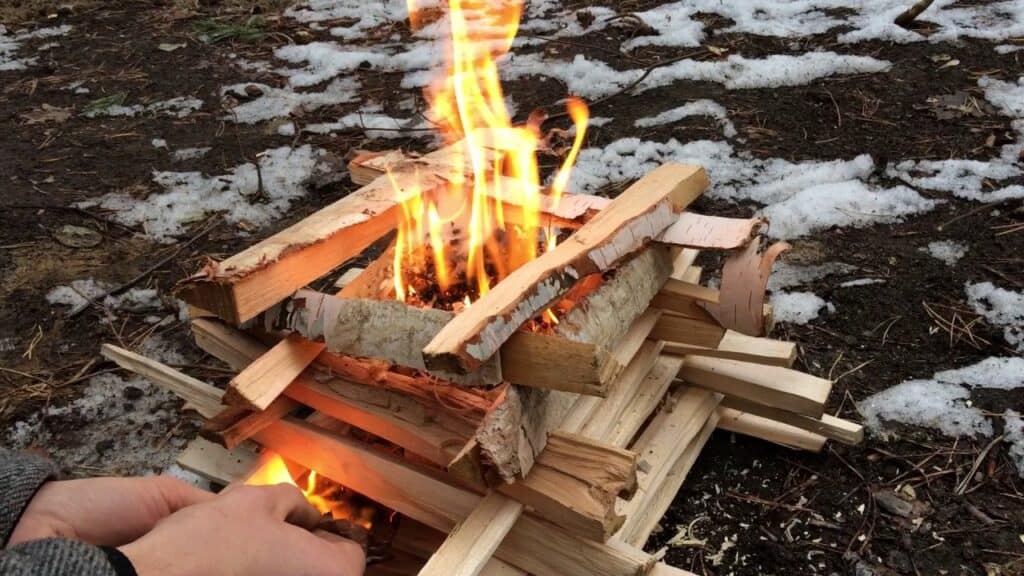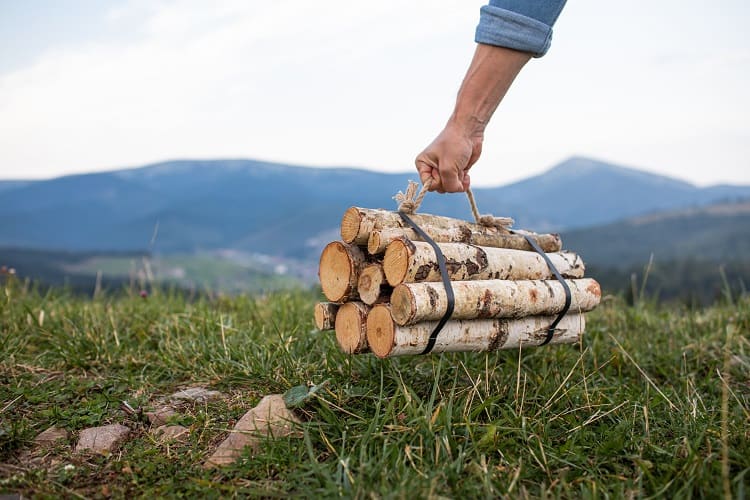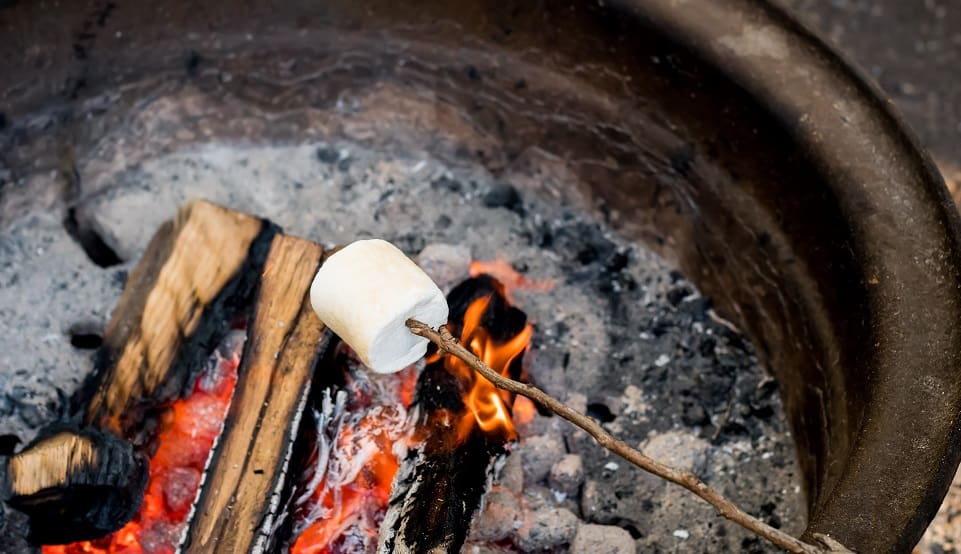A roaring fire pit is often the yard’s focal point, especially when the weather is getting colder. You can follow plenty of methods to start a fire pit.
Still, the process you take may affect the outcome of your fire, including how efficiently it catches alight and how long it burns. You can utilize some of these great tips to make your fire-building process even more practical.
Making Correct Use of Tinder and Kindling

Although sometimes incorrectly used interchangeably, tinder and kindling have very different uses. Tinder is made up of tiny shavings of highly combustible material that burns hot and fast. This type of material is an excellent choice for creating the beginning embers that will make up our fire.
PRO-TIP
Although there are many types of tinder available in nature, such as wood shavings, pine cones, dried grass, and leaves, don’t forget about the things lying around your house, such as purell-soaked cotton buds, traditional fire-lighters, or even potato chips!
Once we have a hot-burning ember, we can add slightly thicker and larger material, which we refer to as kindling. Kindling is typically made up of small branches or twigs with more energy and a longer burning time than tinder. When our kindling is successfully burning, we can then add more significant fuel sources, such as seasoned wood.
Utilizing tinder and kindling in this way allows us to build up our fire procedurally and helps us create a hot, even burn. If you can’t find dry kindling, try splitting open a larger piece of wood and use the drier interior as a replacement.
Wood-Stacking Techniques

You can throw a bunch of wood in your pit and hope it burns, but you’ll probably end up in a hot mess. Instead, you should follow a tested structure. There are quite a few different methods for structuring your firewood; let’s look at some common laying techniques that provide good airflow and stability.
The Teepee
A great structure to learn, the teepee promotes steady burning and can form the basis for more advanced structures, like the star.
- Start with a handful of tinder at the base of the pit.
- Build a small teepee-shaped cone around the tinder stack by leaning small pieces of kindling against each other.
- Continue stacking the kindling in a cone shape, layer by layer, adding larger and larger pieces with each stack.
- Light the tinder and watch your fire grow
The Star
Expanding on the teepee lay, the star will help promote longevity within your structure.
- Build a full-sized teepee that is already burning
- Point out five pieces of wood in a star shape around the teepee. The logs should burn from the center out.
- As we are building this in a fire pit, the logs will slide into the center of the pit as they burn, ensuring the teepee stays alight for longer.
The Log Cabin Fire

This lay works best with wood thicknesses of around an inch, although wood that is slightly thicker at the base is ok. This thickness is ideal as it will allow the fuel to catch alight easily.
- Start with your stack of tinder and kindling in the center of the pit. Use around a cupped hand full of tinder and cover with kindling.
- Begin laying your material in a criss-cross pattern, with two pieces parallel, then two pieces perpendicular on top of this. You shouldn’t need more than four levels of wood.
- It’s time to light up. Your tinder should be combustible enough to set ablaze with one match, and if built correctly, should generally take care of itself during the lighting process.
- As the fire burns, you will add lengths of wood across the roof of the fire, creating the log cabin shape. You can also add extra wood as it continues to burn to add longevity to the fire.
How to Choose Your Wood Type
There are plenty of differences between softwoods and hardwoods, and preferences will vary. However, it is generally accepted that hardwoods are more practical. Regardless of which wood you use, ensuring the wood is properly seasoned, or fully dry, is of the most importance.
Let’s Discuss Hardwoods
Coming from flowering plants, hardwoods are denser than softwood, allowing them to burn for longer and produce more heat overall. Hardwoods require less tending to and burn cleaner with less smoke, ideal in a fire pit scenario in which people will typically gather around the fire.
If you are looking for long-lasting, clean-burning wood, some great choices are oak, ash, cherry, maple, and birch.
And What About Softwoods?

Softwood is typically cheaper and more available than hardwood, with around 80% of the wood in the world being softwood. Softwood burns faster than hardwood as it is less dense and will require more work to keep producing heat. That said, softwood tends to produce a more exciting flame thanks to the less dense structure, with aesthetically pleasing sparks and cracking sounds. Softwoods are also easier to catch alight.
Choosing seasoned pine or cedar is a reliable option if you want a sparkly, wood-cracking atmosphere around your pit.
PRO-TIP
Although softwoods produce much more smoke than their hardwood counterparts, this smoke can be an effective method in repelling mosquitoes in the surrounding area and downwind of the fire pit.
Some Pointers on Safety
When handling a large fire, safety should be of primary importance. Here are some things you may not have considered:
Checking the weather report for rain might seem obvious, but you should also check wind conditions while you’re there. Especially windy days might result in difficulty catching a spark and may cause unforeseen accidents. You can also check the general wind direction to set up seating around the pit away from the direction of the smoke.
Another aspect of fire pit safety that one may easily overlook is that construction materials should never be burned. Many types of lumber used in construction are coated with potentially toxic resins designed to uphold the material for years to come. You don’t want your guests to breathe that in. Do not burn pressure-treated lumber.
Another thing to keep in mind is having a method ready to extinguish your fire. Even if you chose a safe, open location to install your fire pit, you should always consider having a water source on hand to extinguish anything that gets out of hand. You can also consider a small shovel to suffocate any burning embers remaining or even invest in a fire blanket.



